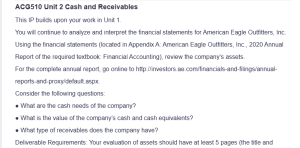ACG510 Unit 2 Cash and Receivables
What are the cash needs of the company?
American Eagle Outfitters (AEO) is a cash-intensive business that needs cash to finance its operations, emerging growth prospects, and international freedom. The major cash requirements involve raw materials and merchandise, rent for store premises, acquisition of stores and stores’ refurbishment, and development of IT facilities for the progression of the online shopping market. Also, they use cash to finance their marketing and promotional strategies to be competitive in the retail apparel industry. Having enough liquidity is essential when there is a possibility of being faced with several challenges, such as changes in supplies or consumers’ preferences.
What is the value of the company’s cash and cash equivalents?
According to the AEO’s latest financial statement- the 2020 Annual Report- the cash and cash equivalent stood at $692. 2 million by the end of the fiscal year, and American 2020 also states that. This large amount of cash suggests that AEO has good liquidity, allowing the company to fund short-term needs and investment opportunities without often looking for external funding. The high cash and cash equivalents also prove helpful when the economy and the markets go through a rough period where operating income is low, and other assets’ values are declining, thus planning for continued operations.
Type of Receivables the Company Has
Trade, credit card, and other miscellaneous are the major categories that make up the total receivables of AEO. Trade receivables relate to purchasers’ balances from amounts owed by buyers for products bought on credit and are usually recovered within one year. Receivables from credit cards pertain to products sold through diverse credit card merchants, which generally take a few days to clear. Other current receivables consist of amounts recoverable from landlords for tenant improvement allowances and all other receivables that are not considered trade accounts (American, 2020). The nature of the company’s receivables is relatively good due to short collection periods, and, more importantly, the counterparty credit risks are desirable.
What type of receivables does the company have?
Current assets play a vital role in the viability of any company and organization since most of the working capital is seen in the retail business (Lee, 2020). The current assets for AEO include Cash and cash equivalents, Receivables, inventories, and prepaid expenses. As the studies relating to the retail industry have shown, firms must manage their current assets properly to stay liquid, support ongoing operations, and be strategic in their methods. Compared to the trends evident among the competitors, AEO’s management of current assets demonstrates the company’s stewardship of liquidity and how inventory corresponds to consumer needs (American, 2020). From the company’s balance sheet, cash and receivables are high while relatively moderate, which suggests that the company’s financial structure enables operational anchoring and growth. AEO’s significant cash and cash equivalents guarantee adequate financial flexibility to satisfy its operational and strategic requirements (Herrmann et al., 2019). The nature of a number of receivables, mainly trade and credit card receivables, emphasizes that these are short-term credit receivables that are predominantly characteristic of a retail format company. Combined with the efficient planning of the cash flows, such financial ratios allow AEO to stay operational grow, and withstand economic fluctuations.
Implications for American Eagle Outfitters, Inc.
Analyzing the financial performance of AEO, it is evident that it has been affected both positively and negatively. First, the specific component of the liquidity ratio indicates substantial cash reserves, which help the company to be ready for crisis periods or to follow specific strategies without interruptions. As is the current retail environment, this financial flexibility is essential in a cutthroat and dynamic industry. Second, effective management of the receivables ties up an adequate amount of money to fund regular operations while also avoiding a high level of implementing bad debtors (Scott & O’Brien, 2023). Third, managing the product’s popularity through inventory levels as part of the current assets enables AEO to have a product stock that will meet the market demands without using a lot of resources, thus increasing its sales and profits.
Some of the assumptions are obtained from the nature of the notes to this financial statement, especially regarding the asset management and overall financial health of AEO. Additional information relating to inventories’ valuation methods, credit risk associated with receivables, and cash and cash equivalents (Herrmann et al., 2019). In particular, analyzing their components, for example, marketable securities or short-term investments, can provide more information about the company’s liquidity management (Schroeder et al., 2022). Notes on receivables may include information on credit policies, including aging schedules and allowances for doubtful accounts receivable, and will contain all the information needed to assess the company’s receivables position at a glance.
Conclusion
From balance sheets and data to financial statements, AEO is a company with an adequate ability to satisfy its cash requirements, control its receivables, and sustain a solid liquidity base. Altogether, these factors improve AEO’s competence in threat management in the retail industry and its continuity, as well as its financial capacity to invest in new growth bulletins and maintain its market position. Thus, by following the essential financial peculiarities mentioned above, AEO can reach long-term perspectives of the organizational operation along with stable financial performance.
References
American Eagle Outfitters, Inc. (2020). Annual Report. American Eagle Outfitters Investor Relations.
Herrmann, D., Thomas, W., & Spiceland, J. D. (2019). Financial Accounting. McGraw-Hill Education.
Lee, T. A. (2020). Financial accounting theory. In The Routledge Companion to Accounting History (pp. 159–184). Routledge.
Schroeder, R. G., Clark, M. W., & Cathey, J. M. (2022). Financial accounting theory and analysis: text and cases. John Wiley & Sons.
Scott, W. R., & O’Brien, P. C. (2023). Financial accounting theory. Zhongguo ren min da xue chu ban she.
ORDER A PLAGIARISM-FREE PAPER HERE
We’ll write everything from scratch
Question
ACG510 Unit 2 Cash and Receivables
This IP builds upon your work in Unit 1.

ACG510 Unit 2 Cash and Receivables

